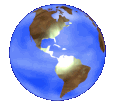

|
|
 
Earth Sciences
- Earth Island Institute
(EII): Provides organizational support in developing projects for the conservation,
preservation, and restoration of the global environment.
-
Earth
Science Resources: A collection of sites (FTP, Gopher, Telnet, Web-HTTP) for
information on Earth & Mineral Sciences - multimedia resources, weather, ocean, space,
ozone, lesson plans, and more.
-
The Earth
System Science Community: Students, teachers and scientists working to understand the
Earth system.
- Earthwatch: The
mission of Earthwatch is to improve human understanding of the planet.
- Education
Resources for Oceanography and Earth Sciences: A list of documents, data, and software
for Education from NASA, UNESCO, the U.S. Geological Survey, the Jet Propulsion Laboratory
(JPL), The National Center for Atmospheric Research (NCAR), National Space Science Data
Center (NSSDC), etc.
- Eratosthenes Finds Diameter of
Earth! (a lesson by Dennis Donovan): Students learn to estimate the diameter and
circumference of the Earth by repeating Eratosthenes' experiment.
-
Florida
Integrating Satellite Program (weather project): Implements the NOAA Direct Readout
Satellite Ground Station Program into Florida's K-12 Classrooms.
-
Fractal
Clouds: Information on the fantastic variety of cloud forms and structures, and their
implications for climate.
- GLOBE: The GLOBE (Global
Learning and Observations to Benefit the Environment) Program - an International
Environmental Education and Science Partnership, a worldwide network of students,
teachers, and scientists working together to study and understand the global environment.
- HLM Math/Science Center:
Interactive sessions and information on water studies for high schools.
- Hurricane Images and
Tracks
- The Institute for Creation
Research: Excellent Creation site!
- International Solar Energy
Society: The umbrella body for solar energy related disciplines.
-
Kids
as Global Scientists: The project focuses on maximizing the educational potential of
an Internet- based middle school weather curriculum that begins with students collecting
their own weather data.
- Live
From Antarctica: A Passport to Knowledge project designed to allow students and
teachers the opportunity to experience what life is like in the coldest place on the
planet, Antarctica.
- Mathematical
Life Sciences Archives - UTK: Artificial Life and Complex Systems.
-
Meteorology Education
Resources: Links to major weather sites. Also lesson plans, labs and other curriculum
development.
- Miami Museum of Science:
Online resources include Hurricane - Storm Science: how hurricanes work and planes flying
into them; Internet Island: how to use the Internet in a classroom; and The pH Factor:
find the pH of various substances. Lesson plans.
- Mining Co.'s Geography
site
- The
Mountain: Links to extensive lists of resources on cardiology, biomedical engineering,
anesthesiology, and other medical resources.
- The
Nanoworld Home Page (CMM): The Centre for Microscopy and Microanalysis is an
interdisciplinary research and service facility dedicated to an understanding of the
structure and composition of all materials at atomic, molecular, cellular and
macromolecular scales.
-
National
Geographic Society Online: Apply for your passport, and click on the icons within it,
or the hot-links on the Boarding Pass, to link directly to features prepared exclusively
for cyberspace.
- Native Americans and the
Environment: Extensive bibliographies on environmental issues and concerns facing
native peoples; documents on these issues.
- Nature's Structural
Elements: Gifs of nature's structural elements, compounds, and some derived
structures. To access the gif for an element or compound, click on a description.
-
The
Nature Study Online Project is an
extensive noncommercial site teaching basic nature-study
techniques. Students identify and list plants and animals around
their own homes. Online forums enable the lists to be posted and
compared with others from across North America. Data on seasonal
behavior of plants and animals can be posted at an online database,
thus documenting whether global warming is taking place.
-
Sample
Classroom Activities - Network Montana Project: Measuring Mars: A Visit To Olympus
Mons; Measuring Global Sea Surface Temperatures; Exploring Phytoplankton Pigment
Concentrations; Storm Trackers.
- Seek - Sharing
Environmental Education Knowledge: Minnesota's Interactive Directory Environmental
Education Resources. Search for information about environmental education, and find
information about current environmental projects in Minnesota.
- SKYMATH
National Weather Report Module: This web site provides an overview of an instruction
unit in which students produce a national weather report and a report on their
understanding of various weather phenomena.
-
The Solar Cooking
Archive: Solar Cookers International (SCI) and Solar Box Cookers Northwest (SBCN) are
mostly volunteer organizations, and the spread of solar cooking is basically
people-to-people.
- Tides
and Tide Prediction: General stuff about tides and tide prediction. Priming/Lagging: a
calculus with calculators exercise demonstrating the priming and lagging of the tides at
Stony Brook.
- TOPEX/POSEIDON
CD-ROM: Perspectives on an Ocean Planet: This site provides a comprehensive look at
the TOPEX/POSEIDON mission and satellite through text, video clips, scientific data, and
images.
-
Tracking a Hurricane:
Students plot rectangular and polar coordinates on rectangular coordinate graphing paper.
- U.S. Geological Survey:
Scientific fact-finding and research organization of the U.S. Dept. of the Interior.
- U.S.
Water Use - 1990: Questions and answers about water from the U.S. Geological Survey
(USGS). Topics covered include: Water use in the United States, USGS water data and
measurements; Water use in your home; Chemistry and water. Links to other sites about
water.
-
UCMP
Geological Time Machine: Learn all about geology with this extensively annotated time
line of the history of the earth. Follow links to an Introduction to Geology, or to a
specific geologic time period. Searchable.
-
UIUC CoVis Geosciences Web
Server: This version of the CoVis Geosciences Web Server is provided by the Department
of Atmospheric Sciences (DAS) at the University of Illinois (UIUC).
- US Geological
Survey (USGS): A Bureau of the U.S. Department of the Interior and the nation's
largest earth science research and information agency.
- VolcanoWorld Home
Page: VolcanoWorld has a very easy to use, Hypercard-like interface with lots of
options.
- Weather
Underground: From the Department of Atmospheric, Oceanic and Space Science at the
University of Michigan.
- WeatherNet:
The Internet's premier source of weather links. List of weather pages, meteorology
departments, maps, forecast services.
- WebWeather:
A set of scripts that provides a simple user interface for getting weather conditions and
forecasts from the University of Michigan Weather Underground.
- What is an El Nino?:
Schematic diagram of normal and El Nino conditions in the Pacific Ocean, and (b) wind and
temperature on the Equator at 110W El Nino is a disruption of the ocean-atmosphere system
in the tropical Pacific having important consequences for weather around the globe.
- The
Wilderness Society: A national conservation organization devoted to public lands
protection and management issues.
-
X-Nilo: Excellent Site! Promotes a Biblical worldview through examining
various views of origins.
Email: Edu-Links Administrator |